|
|
|
|
|
Lynnfield i5 or i7 - This is the Question |
|
Join the community - in the OCAU Forums!
|
Productivity and Gaming Results
PRODUCTIVITY AND GAMING RESULTS:
Cinebench R10 is a 3D graphic application benchmark. It renders a high-resolution model of a motorcycle and gives a score at the end. It utilizes as many cores as are available. POV-Ray is a rendering application as well. As with Cinebench it runs multithreaded using as many cores as are available. Both applications take full advantage of hyperthreading. For a more precise performance analysis, it is possible to tell the built-in benchmark the precise number of threads to run. We did run both applications single-threaded and then again multithreaded with the maximum number of threads: 8 threads with the 920 and 860, and 4 threads for all other quad-core CPUs.
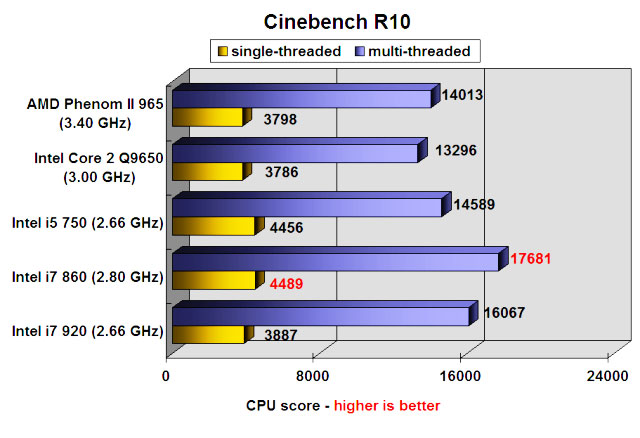
Single-threaded rendering shows the 860 ahead of the 920. This is not surprising because the combination of an already 133MHz higher base frequency with a more aggressive Turbo Boost makes for a substantially higher top frequency. The 750 as well is faster than the 920, apparently thanks to the more aggressive Turbo Boost.
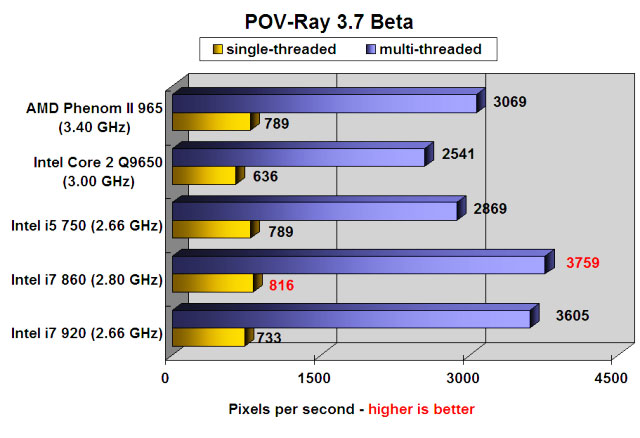
The picture looks much different when the same tests are done multithreaded. The 860 and the 920 are rendering with 8 threads, while the 750 and all other CPUs are confined to 4 threads. The 750 is now falling behind the 920, but still far ahead of the Q9650 and the Phenom II X4 965.
You will see a similar tendency in WinRAR. This compression utility is running multithreaded as well, and hyperthreading is therefore enhancing performance. The result of the built-in benchmark is given in kilobyte/sec. Have a look at the 920 and the 750: When running single threaded both perform identically, while multithreaded the 920 is 10% faster because it runs the task with 8 threads, while the 750 is limited to 4 threads.
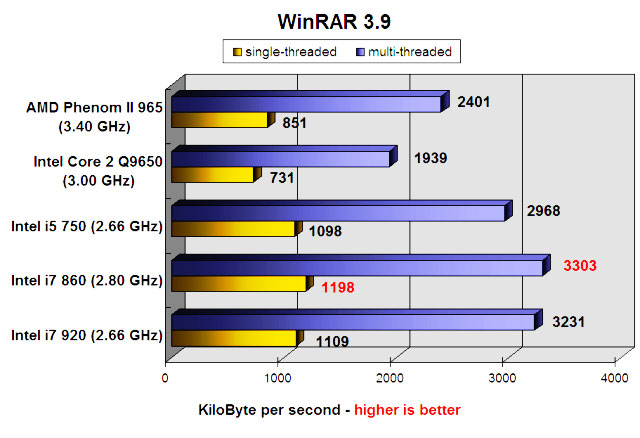
The 2 MS Office Excel tests we are using are provided by Intel. They are scripted in a way showing the advantage of multithreading with Intel multi-core processors. The 920 is leading the equally clocked 750 by up to 15% in this benchmark, thanks to its hyperthreading capability. The i7 860 is again the winner here, as it also benefits from hyperthreading and is higher clocked than the 920. The AMD processor falls far behind in this (Intel-provided) benchmark.
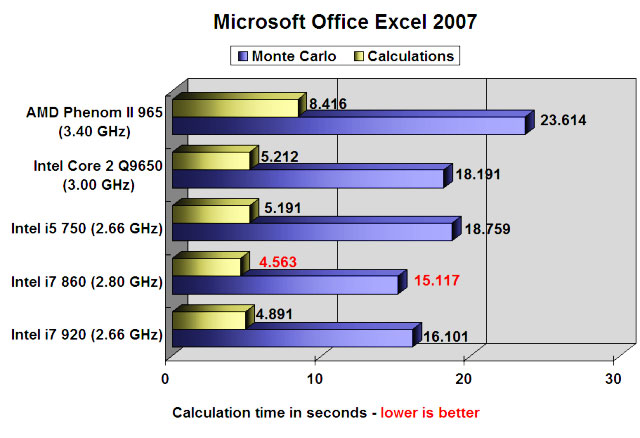
AVG 8.5 (virus checking) and MainConcept (video transcoding) are running multithreaded and taking therefore advantage of HT capability as well. Again you can see that the 860 is slightly ahead of the 920, and both are much faster than the 750.
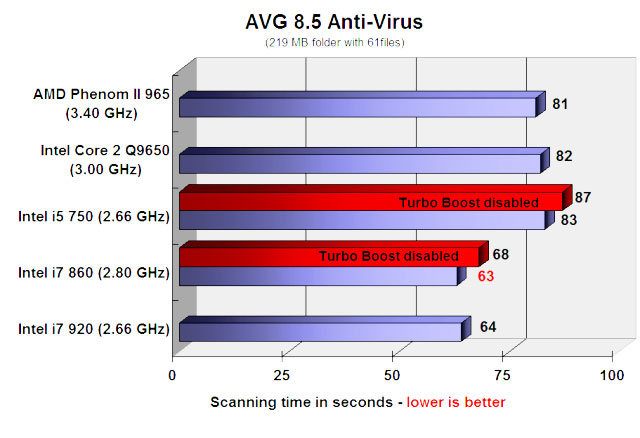
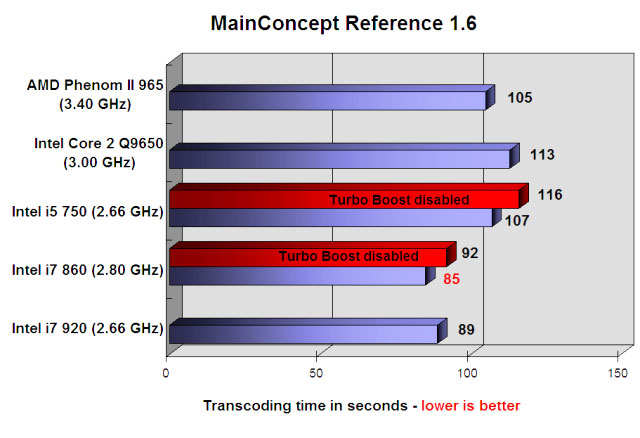
iTunes is running mainly single threaded. The 920 has therefore no advantage here against the 750. As a result the 750 is even faster encoding with iTunes than the 920, because of its more aggressive Turbo Boost.
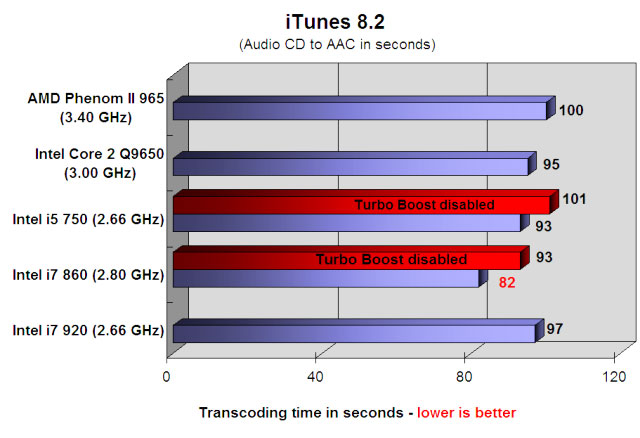
Turbo Boost is enabled by default, at least in the BIOS of Intel’s P55 mainboard. We kept it this way, and all results shown for “Lynnfield” are therefore “turboboosted”. In order to check out the impact of TB we re-run AVG, MainConcept and iTunes with TB disabled. If you view our i7 Bloomfield article from November 2008 you will see that Turbo Boost is increasing the performance of an i7 900 series processor by 3% - 5% depending on the application. That was an “intriguing “new approach, but not exactly impressive in terms of additional performance. The more aggressive implementation of TB with Lynnfield is more than doubling the Turbo impact. The multithreaded running AVG and MainConcept are boosted by 6 % to 8%. The single-threaded running iTunes is gaining almost 13%.
To understand the reason for the difference, please remember what we explained already about the way TB is working: If only one core is running, the frequency of this core can be boosted by up to 5 speed bins (4 bins for the i5). If more than 2 cores are engaged, which is normally the case when multithreaded applications are running; the frequency of these cores can be increased by only 2 speed bins. A real-word performance increase of 6% to 12% without any user intervention or hassle involved is impressive. Although TB is often called “overclocking”, it’s not exactly the same. While an overclocked system is running at all times at the user specified processor frequency, TB is “dynamic”. It kicks in only and to the extent the power consumption and other system resources allow. Another caveat is that TB cannot be “controlled”. You can disable it, but if it is enabled it kicks in automatically if certain conditions are met. The only way the user can influence TB is to provide the best possible cooling, because the processor's operating temperature is a major factor in how TB will behave.
It’s saddening to see AMD’s flagship processor performing that much behind. Since Intel replaced ”NetBurst” with the much more efficient “Core” micro-architecture in 2006, AMD has been falling more behind with every new processor generation Intel has introduced. AMD has already reacted to the release of Lynnfield by slashing prices. Their flagship Phenom II X4 965 is now retailing for around $260. This price puts it exactly between a 750 and the 860/920. While this price might keep it attractive for the time being, it does not really solve their problem. Apparently AMD needs a new micro-architecture to regain performance competitiveness.
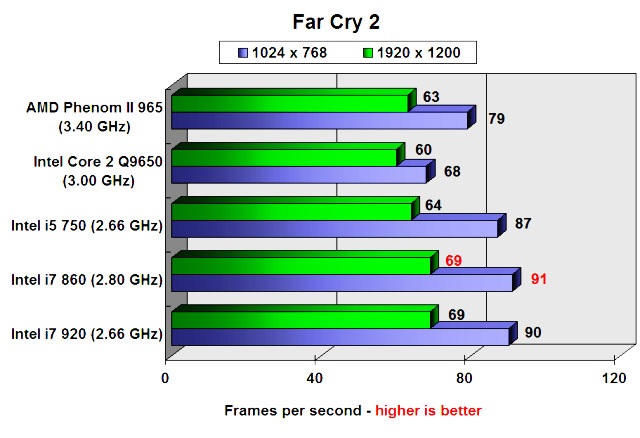
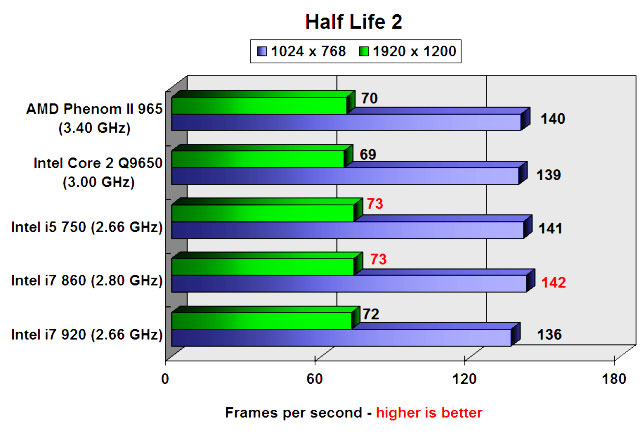
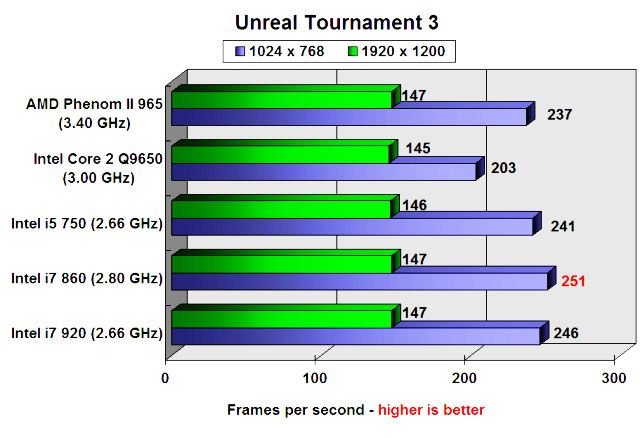
Gaming performance was tested with a single graphics card. In order to show the impact of the CPUs and differentiate between them as much as possible, we tested with 3 games that are known to be “CPU bound” at resolutions of 1024 x 768 and 1920 x 1200. While the lower resolution is certainly not the way you run such a game unless it is with an entry level graphic card, it allows better to differentiate between processor performances. At higher resolutions the GPU is almost always the bottleneck.
In all 3 games and with both resolutions the 860 is besting the competition, followed either by the 920 or the 750. The Phenom comes in at 4th place, while the Q9650 performs worst. “Worst” is relative though, because the differences are rather small, and at 1920 x 1200 negligible. In particular Unreal Tournament loves extra CPU power. At 1024 x 768 you get a difference of around 20% between the 860 and the Q9650. But even with this game the difference became almost zero in 1920 x 1200. Although the Nehalem based i5 and i7 processors are clearly taking the lead, any of the other CPUs in combination with a newer graphics card will do well when running these games. The results also show that moving the PCI Express graphic lanes from the Northbridge on the Lynnfield processor core is not limiting gaming performance in any way. This might be different for the already mentioned reason when gaming with multiple graphic cards. In this case the 920 is most probably a better choice than a Lynnfield system.
|
|
Advertisement:
All original content copyright James Rolfe.
All rights reserved. No reproduction allowed without written permission.
Interested in advertising on OCAU? Contact us for info.
|

|


